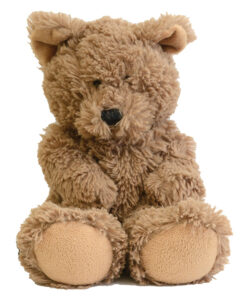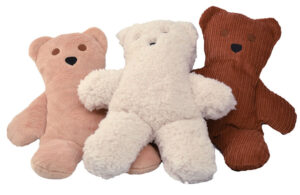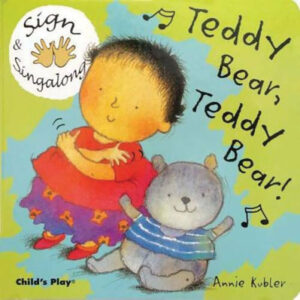Social interaction skills
An infant participates in responsive interactions with a caregiver focused on a teddy bear.



[Place the infant on his/her back on a pillow/cushion so the infant is supported in a reclining position.
Smile and begin talking with the infant. Example: “Good morning, Antonella! I am happy to see you today. Would you like to play with me?” Acknowledge the infant’s reactions, including any vocalizations, facial expressions, and/or gestures. Example: “You are looking at me and smiling. I think you want to play!”]
 [Introduce the teddy bear by holding it about 12 inches from the infant. Move the teddy bear slowly from side to side to attract the infant’s attention.]
[Introduce the teddy bear by holding it about 12 inches from the infant. Move the teddy bear slowly from side to side to attract the infant’s attention.]
Look, I have a special friend with me today!
[Wave the bear’s hand to pretend the bear is saying hello. Use a different voice for the bear. Example: “Hello, Gabriel, hello!”]
Hello, teddy bear, hello! The teddy bear is waving hello! Do you see the teddy bear waving?
Do you want to wave ‘hello’ to the teddy bear?
[Demonstrate waving back to the bear.
Using your voice, rather than the bear’s, describe the infant’s response to the bear. Example: “You are kicking your legs! You are watching the teddy bear. Let’s see what the teddy bear is going to do next!”
Use the bear to interact with the infant for several moments. Invite the infant to touch the bear. Example (using bear’s voice): “I have soft fur. Would you like to touch my hand?” Bring the bear to the infant’s hand to touch if the infant seems interested but does not reach or grasp. Describe and respond to any vocalizations or gestures the infant offers during interactions with the bear.
Announce that it is time for the bear to leave.]
It is time for the teddy bear to go bye-bye!
[Wave the bear’s hand toward the infant to pretend the bear is saying “bye-bye.” Use a different voice for the bear. Example: “Bye-bye, Regina, bye-bye!”]
The teddy bear is waving bye-bye! Do you see the teddy bear waving?
Do you want to wave bye-bye to the teddy bear?
[Demonstrate waving back to the bear.]
Bye-bye, teddy bear, bye-bye!
[Describe the infant’s vocalizations or gestures, paying particular attention to any attempt to wave at the bear. Example: “You are waving your arms. You are saying ‘bye-bye’ to the teddy bear! Bye-bye teddy bear!”]
[Briefly describe highlights of the interaction. Example: “We had fun talking to the teddy bear! The teddy bear waved hello! You smiled and watched the teddy bear. You touched the teddy bear’s hand. Then the teddy bear waved bye-bye! We waved bye-bye to the teddy bear.”]
Social interaction skills
Infants are encouraged to imitate a caregiver’s simple actions with a teddy bear.



 Invite several infants to join you to play with teddy bears that are positioned in an appealing way in the activity space. Introduce the bears and encourage infants to wave hello to the bears. Example: “We have some teddy bears to play with today! (Demonstrate waving to the bears.) Hello, teddy bears! Let’s all wave hello to the teddy bears!” Encourage the infants to wave hello to the bears.
Invite several infants to join you to play with teddy bears that are positioned in an appealing way in the activity space. Introduce the bears and encourage infants to wave hello to the bears. Example: “We have some teddy bears to play with today! (Demonstrate waving to the bears.) Hello, teddy bears! Let’s all wave hello to the teddy bears!” Encourage the infants to wave hello to the bears.
Give each interested infant a bear. Have the bear wave hello to the infant as you present the bear to an infant. Acknowledge each infant’s response to receiving a teddy bear, including any attempt to wave at a bear.
Use a teddy bear to encourage infants to wave to their peers during a simple song you offer. Use a tune of your choice to say “hello” to each infant in the gathering in the following way:
Hello, (child’s name).
Hello, (child’s name).
Hello, (child’s name).
Hello, hello, hello!
Use exaggerated waving motions each time you sing “hello.” Infants may wave with their hands or use the arms of their bears.
After the song, encourage infants to play with their bears for several moments. Describe infants’ actions and look for opportunities to imitate the actions of the infants with the bears. Example: “Ava is jumping her teddy bear up and down. Let’s jump our bears up and down like Ava is!”
Announce that it is time for the bears to say goodbye. As you collect the bears, have each bear wave goodbye to an infant. Encourage infants to wave back to the bears. Acknowledge each infant’s attempt to wave at the bears. Example: “Ava is waving bye-bye. Cayden is waving bye-bye. Bye-bye, teddy bears!”
Social interaction skills
Infants participate in a book sharing that includes an opportunity to move teddy bears in ways similar to movements described in the book.



Be Prepared: The activity uses the last two pages of the book only (illustrations of different movements). Omit the “turn out the light” action because it illustrates a sign vocabulary not emphasized in today’s activity. Select movements you wish to promote with infants in your small gathering. It is not necessary to use each of the illustrated movements.
 Invite several infants to join you in looking at pictures of a teddy bear doing different things. Show the last two pages of the book. Give each infant a teddy bear to hold. Position the board book so it can stand on its own, showing the last two pages, so you can use your hands to point to an illustration (such as “touch your nose”) and then manipulate your teddy bear to show the illustrated movement. Use simple words to describe actions. As noted in Be Prepared, omit the “turn out the light” illustration.
Invite several infants to join you in looking at pictures of a teddy bear doing different things. Show the last two pages of the book. Give each infant a teddy bear to hold. Position the board book so it can stand on its own, showing the last two pages, so you can use your hands to point to an illustration (such as “touch your nose”) and then manipulate your teddy bear to show the illustrated movement. Use simple words to describe actions. As noted in Be Prepared, omit the “turn out the light” illustration.
After you review and demonstrate some teddy bear movements, invite infants to move their teddy bears, too. Example: “We can move our teddy bears like the bear shown in our book.” Follow a pattern of pointing to and simply describing an illustration (Example: “Our teddy bear is touching its toes!”), and then encouraging infants to move their bear in a way you demonstrate (Example: “Let’s all have our teddy bear touch its toes!”). Some infants may wish to watch rather than imitate your actions. Conclude the activity by briefly describing what happened.
 There are likely to be differences across infants in how they respond to an activity. Example: In Option 1, an infant may show interest in playing with you by gazing, vocalizing, kicking his/her legs, or reaching toward you. Be flexible about each infant’s responses to an activity. Some infants may not imitate the hand motions of waving in Option 3 or your demonstrated movements during Option 3. Some infants may move their bodies, rather than their teddy bear, in Option 3. Look for and enthusiastically acknowledge facial expressions or vocalizations that show interest in an activity. Remember that infants who prefer to watch and listen are learning through observation. Option 3 is more challenging than Option 2 because it potentially involves more ways to move a toy bear and uses book illustrations (in addition to your demonstration) as an example of what to do with a toy bear. It is cognitively helpful for infants to see you demonstrate what is happening in an illustration.
There are likely to be differences across infants in how they respond to an activity. Example: In Option 1, an infant may show interest in playing with you by gazing, vocalizing, kicking his/her legs, or reaching toward you. Be flexible about each infant’s responses to an activity. Some infants may not imitate the hand motions of waving in Option 3 or your demonstrated movements during Option 3. Some infants may move their bodies, rather than their teddy bear, in Option 3. Look for and enthusiastically acknowledge facial expressions or vocalizations that show interest in an activity. Remember that infants who prefer to watch and listen are learning through observation. Option 3 is more challenging than Option 2 because it potentially involves more ways to move a toy bear and uses book illustrations (in addition to your demonstration) as an example of what to do with a toy bear. It is cognitively helpful for infants to see you demonstrate what is happening in an illustration.
Extra support
Enrichment
Materials Needed: several teddy bears or other stuffed animals
Provide opportunities for infants to independently explore the teddy bears. Imitate their actions. Invite infants to imitate the actions of a peer.
Materials Needed: Sign and Sing Along: Teddy Bear, Teddy Bear! by Annie Kubler
Invite toddlers and preschool-age children in your setting to join Option 3. Most or all are likely to be familiar with the teddy bear movements. Invite children to imitate the movements of the teddy bears in the pictures as you read the book. Older children may enjoy reciting some of the words of the rhyme with you.